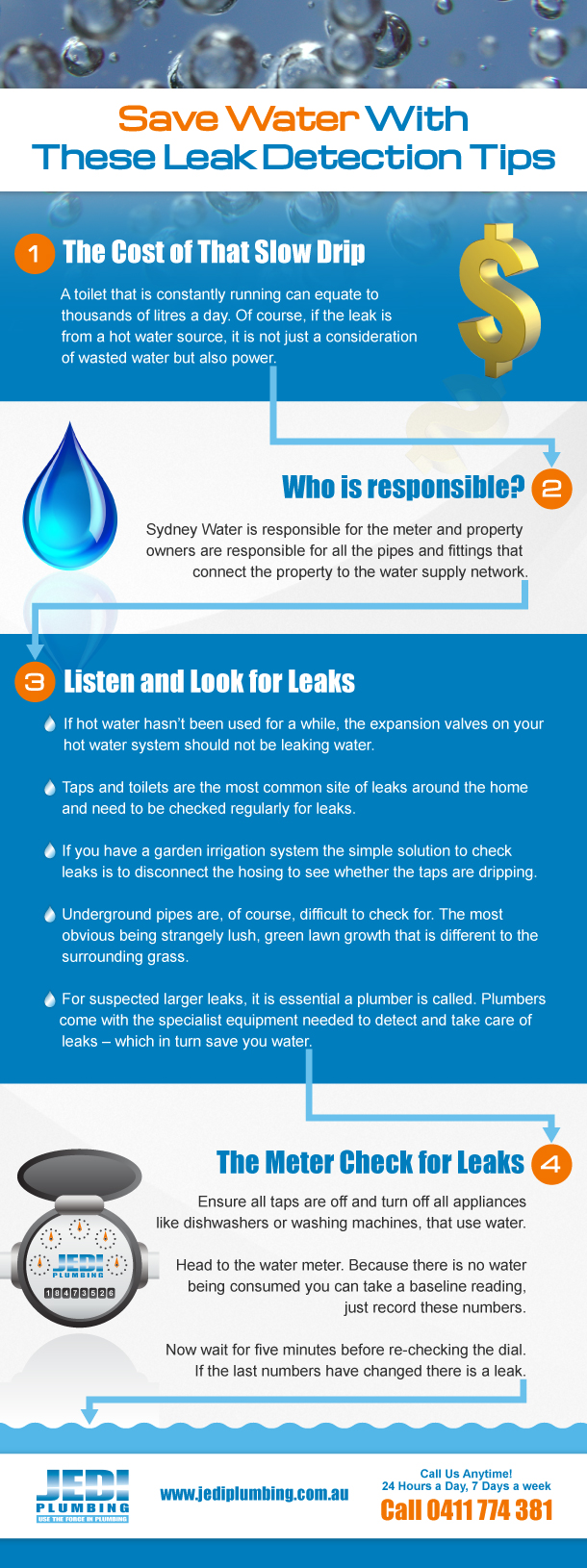Water restrictions and the rising cost of water have forced households to become more water wise. There are many tips for consumers to save water at home but possibly the best place to begin is detecting and fixing leaks.
The Cost of That Slow Drip
A dripping tap is a problem of more than ‘just a few drops’. Most home owners would be unaware that those few drops can equal a few litres of water down the drain every hour. A toilet that is constantly running is even more serious and can equate to thousands of litres a day.
Of course, if the leak is from a hot water source, or is from a pumped water source, it is not just a consideration of wasted water but also power. A leak that wastes water and power costs you significantly.
Who is responsible?
In Sydney, properties are connected to the water supply network by Sydney Water. Whilst Sydney Water is responsible for the meter, property owners are responsible for all the pipes and fittings that connect the property to the water supply network.
It is important if a leak is suspected that a licensed plumber, like in the Northern Beaches, our JEDI Plumbing service, is called.
Listen and Look for Leaks
Many homeowners would be familiar with the sound of a constantly running toilet, or have seen signs they have suspected as being water leaks. Here are some tips and ways to check for leaks around the home.
* At a point in the day, sometime after the last hot water use, check the expansion valves on your hot water system. If hot water hasn’t been used for a while the valve should not be leaking water. It should never constantly be leaking water.
* Taps and toilets are the most common site of leaks around the home. These need to be checked regularly both for visible leaks and for the sound of leaks. One simple check for a leaky cistern is to leave a piece of toilet paper behind the toilet bowl. The dry toilet paper should remain dry until the next flush.
* If you have a garden irrigation system leaking taps can be hidden, so the simple solution to check for leaks is to disconnect the hosing or pipes to see whether the taps are dripping.
* Underground pipes are, of course, difficult to check for leaks because they are hidden. However there will always be telltale signs you can look for. The most obvious being strangely lush, green lawn growth that is different to the surrounding grass.
* Minor leaking taps may just be a simple tap washer fix, but for suspected larger leaks, it is essential a plumber is called. Plumbers come with the specialist equipment needed to detect and take care of leaks – and save you water.
The Meter Check for Leaks
Most properties have an individual water meter so checking for leaks is usually a simple process.
The first step is to ensure all taps are off and to turn off all appliances, like dishwashers or washing machines, that use water. To use the water meter to check for leaks no water can be being used at the time of the check.
The second step is to head to the water meter. Because there is no water being consumed you can take a baseline reading. There are red and black numbers on the dial of the water meter – just record these numbers.
After recording the numbers wait for five minutes before re-checking the dial. If the last numbers have changed there is a leak. The larger and more damaging the leak, the bigger the difference between the baseline and the five minute check will be.
If the water meter check indicates a leak, and you’re on Sydney’s Northern Beaches, then it is time to call us at JEDI Plumbing!


